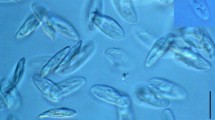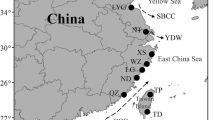Abstract
Laboratory populations of Tubifex tubifex from mitochondrial (mt)16S ribosomal DNA (rDNA) lineage III were generated from single cocoons of adult worms releasing the triactinomyxon stages (TAMs) of the myxozoan parasite, Myxobolus cerebralis. Subsequent worm populations from these cocoons, referred to as clonal lines, were tested for susceptibility to infection with the myxospore stages of M. cerebralis. Development and release of TAMs occurred in five clonal lines, while four clonal lines showed immature parasitic forms that were not expelled from the worm (non-TAM producers). Oligochaetes from TAM- and non-TAM-producing clonal lines were confirmed as lineage III based on mt16S rDNA and internal transcribed spacer region 1 (ITS1) sequences, but these genes did not differentiate these phenotypes. In contrast, random amplified polymorphic DNA analyses of genomic DNA demonstrated unique banding patterns that distinguished the phenotypes. Cohabitation of parasite-exposed TAM- and non-TAM-producing phenotypes showed an overall decrease in expected TAM production compared to the same exposure dose of the TAM-producing phenotype without cohabitation. These studies suggest that differences in susceptibility to parasite infection can occur in genetically similar T. tubifex populations, and their coexistence may affect overall M. cerebralis production, a factor that may influence the severity of whirling disease in wild trout populations.


Similar content being viewed by others
References
Andree KB, El-Matbouli M, Hoffman RW, Hedrick RP (1998) A nested polymerase chain reaction for the detection of genomic DNA of Myxobolus cerebralis in rainbow trout (Oncorhynchus mykiss). Dis Aquat Org 34:145–154
Antonio DB, Andree KB, McDowell TS, Hedrick RP (1998) Detection of Myxobolus cerebralis in rainbow trout and oligochaete tissues by using a nonradioactive in situ hybridization (ISH) protocol. J Aquat Anim Health 10:338–347
Arsan L, Hallett S, Bartholomew J (2007) Tubifex tubifex from Alaska and their susceptibility to Myxobolus cerebralis. J Parasitol 93 (in press)
Baldo L, Ferraguti M (2005) Mixed reproductive strategy in Tubifex tubifex (oligochaeta, tubificidae)? J Exp Zool 303A:168–177
Beauchamp KA, Kathman RD, McDowell TS, Hedrick RP (2001) Molecular phylogeny of tubificid oligochaetes with special emphasis on Tubifex tubifex (Tubificidae). Mol Phylogenet Evol 19:216–224
Beauchamp KA, Gay M, Kelley GO, El-Matbouli M, Kathman RD, Nehring RB, Hedrick RP (2002) Prevalence and susceptibility of infection to Myxobolus cerebralis and genetic differences among populations of Tubifex tubifex. Dis Aquat Org 51:113–121
Beauchamp KA, Kelley GO, Nehring RB, Hedrick RP (2005) The severity of whirling disease among wild trout corresponds to the differences in genetic composition of Tubifex tubifex populations in Central Colorado. J Parasitol 91:53–60
Beauchamp KA, El-Matbouli M, Gay M, Georgiadis MP, Nehring RB, Hedrick RP (2006) The effect of cohabitation of Tubifex tubifex (Oligochaeta: Tubificidae) populations on infections to Myxobolus cerebralis (Myxozoa: Myxobolidae). J Invertebr Pathol 91:1–8
Costello MJ (1996) Development of future cleaner-fish technology and other biological control techniques in fish farming. In: Wilson C, Sayer MDJ, Treasurer JW, Costello MJ (eds) Wrasse: biology and use in aquaculture. Fishing News Books, Oxford, UK, pp 171–184
El-Matbouli M, Hoffmann RW (1998) Light and electron microscopic study on the chronological development of Myxobolus cerebralis in Tubifex tubifex to the actinosporean stage of triactinomyxon. Int J Parasitol 28:195–217
El-Matbouli M, McDowell TS, Antonio DB, Andree KB, Hedrick RP (1999) Effect of water temperature on the development, release, and survival of the triactinomyxon. J Parasitol 29:627–641
Gilbert MA, Granath WO Jr (2001) Persistent infection of Myxobolus cerebralis, the causative agent of whirling disease in Tubifex tubifex. J Parasitol 87:101–107
Granath WO Jr, Gilbert MA (2002) Review: The role of Tubifex tubifex (Annelida: Oligochaete: Tubificidae) in the transmission of Myxobolus cerebralis (Myxozoa, Myxosporea: Myxobolidae) In: Bartholomew JL, Wilson C (eds) Whirling disease: reviews and current topics. American Fisheries Society Symposium Series 29, American Fisheries Society, Bethesda, MD pp 79–85
Hedrick RP, El-Matbouli M (2002) Recent advances with taxonomy, life cycle, and development of Myxobolus cerebralis in the fish and oligochaete hosts. In: Bartholomew JL, Wilson C (eds) Whirling disease: reviews and current topics. American Fisheries Society Symposium Series 29, American Fisheries Society, Bethesda, MD pp 45–53
Hedrick RP, El-Matbouli M, Adkison MA, MacConnell E (1998) Whirling disease: re-emergence among wild trout. Immunol Rev 162:365–376
Higgins DG, Sharp PM (1989) Fast and sensitive multiple sequence alignments on a microcomputer. Comput Appl Biosci 5:151–153
Hofer B (1903) Ueber die Drehkrankheit der Regenbogenforelle. Allgemeinen Fischerei-Zietung 8:7–8
Hoffman GL (1990) Myxobolus cerebralis, a worldwide cause of salmonid whirling disease. J Aquat Anim Health 2:30–37
Kent ML, Andree KB, Batholomew JL, El-Matbouli M, Desser S, Xiao C, Devlin RH, Hedrick RP, Khattra L, Palenzuela O, Siddall M (2001) Recent advances in our knowledge of the Myxozoa. J Eukaryot Microbiol 48:395–413
Kerans BL, Rasmussen C, Stevens R, Colwell A, Winton JR (2004) Differential propagation of the metazoan parasite Myxobolus cerebralis by Limnodrillus hoffmeisteri, Ilyodrilus templetoni, and genetically distinct strains of Tubifex tubifex. J Parasitol 90:1366–1373
MacConnell E, Vincent ER (2002) The effects of Myxobolus cerebralis on the salmonid host. In: Bartholomew JL, Wilson C (eds) Whirling disease: reviews and current topics. American Fisheries Society Symposium Series 29, American Fisheries Society, Bethesda, MD pp 95–107
Markiw ME, Wolf K (1983) Myxosoma cerebralis (Myxozoa: Myxosporea) etiologic agent of salmonid whirling disease requires tubificid worms (Annelida: Oligochaeta) in its life cycle. J Protozool 30:561–564
Nehring RB, Walker PG (1996) Whirling disease in the wild: the new reality in the intermountain west. Fisheries 21:28–30
Nehring RB, Thompson KG, Catanese M (2005) Decline in TAM production in Windy Gap Reservoir: is it linked to major shift in relative abundance of tubificid lineages? 11th Annual Whirling Disease Symposium: “Recipes for Recovery”, Denver, CO, pp 9–10
Nickum D (1999) Whirling disease in the United States: a summary of progress in research and management. Coldwater Conservation Fund, Trout Unlimited
Rasmussen C, Zikovich J, Winton JR, Kerans B (2007) Variability in triactinomyxon production from Tubifex tubifex populations from the same mitochondrial DNA lineage infected with Myxobolus cerebralis, the causative agent of whirling disease in salmonids. J Parasitol (in press)
Rognlie MC, Knapp SE (1998) Myxobolus cerebralis in Tubifex tubifex from a whirling disease epizootic in Montana. J Parasitol 84:711–713
Rose JD, Marrs GS, Lewis C, Schisler G (2000) Whirling disease behavior and its relation to pathology of the brain stem and spinal cord in rainbow trout. J Aquat Anim Health 12:107–118
Slootweg R, Malek EA, McCullough FS (1994) The biological control of snail intermediate hosts of schistosomiasis by fish. Rev Fish Biol Fish 4:67–90
Steinbach-Elwell LC, Kerans BL, Rasmussen C, Winton JR (2006) Interactions among two strains of Tubifex tubifex (Oligochaeta: Tubificidae) and Myxobolus cerebralis (Myxozoa). Dis Aquat Org 68:131–139
Stevens RB, Kerans BL, Lemmon JC, Rasmussen C (2001) The effects of Myxobolus cerebralis myxospore dose on triactinomyxon production and biology of Tubifex tubifex from two geographic regions. J Parasitol 87:315–321
Sturmbauer C, Opadiya GB, Niederstatter H, Riedmann A, Dallinger R (1999) Mitochondrial DNA reveals cryptic oligochaete species differing in cadmium resistance. Mol Biol Evol 16:967–974
Thompson JD, Gibson TJ, Plewniak F, Jeanmougin F, Higgins DG (1997) The CLUSTAL_X windows interface: flexible strategies for multiple sequence alignment aided by quality analysis tools. Nucleic Acids Res 25:4876–4882
Welsch J, McClelland M (1990) Fingerprinting genomes using PCR with arbitrary primers. Nucleic Acids Res 18:7213–7218
Wolf K, Markiw ME (1984) Biology contravenes taxonomy in the Myxozoa: new discoveries show alternation of invertebrate and vertebrate hosts. Science 225:1449–1452
Wolf K, Markiw ME, Hiltunen JK (1986) Salmonid whirling disease: Tubifex tubifex (Muller) identified as the essential oligochaete in the protozoan life cycle. J Fish Dis 9:83–85
Vincent ER (1996) Whirling disease and wild trout: the Montana experience. Fisheries 21:32–34
Acknowledgments
This work was supported in part by the US Fish and Wildlife Service and the Whirling Disease Foundation. Experiments were conducted in compliance with the current laws of the USA. The mention of trade names does not imply endorsement by the US government.
Author information
Authors and Affiliations
Corresponding author
Rights and permissions
About this article
Cite this article
Baxa, D.V., Kelley, G.O., Mukkatira, K.S. et al. Arrested development of the myxozoan parasite, Myxobolus cerebralis, in certain populations of mitochondrial 16S lineage III Tubifex tubifex . Parasitol Res 102, 219–228 (2008). https://doi.org/10.1007/s00436-007-0750-1
Received:
Accepted:
Published:
Issue Date:
DOI: https://doi.org/10.1007/s00436-007-0750-1




